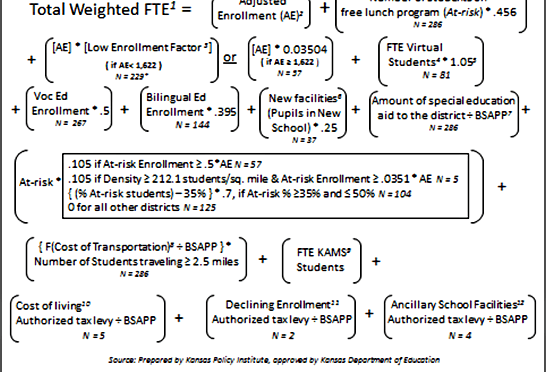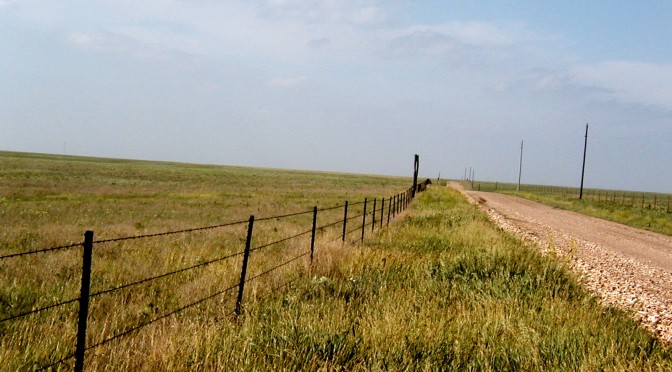From Kansas Policy Institute.
Duane Goossen distorts the truth on education finance
By Dave Trabert
Former state budget director Duane Goossen’s recent blog post entitled “Woe to Education Finance” is yet another example of data being deliberately distorted or falsified for political gain. Mr. Goossen served as budget director under governors Graves, Sebelius and Parkinson and has been a vocal critic of anything even hinting at efficient government…let alone lower tax burdens. Indeed, his post concludes, “The fallout from the governor’s tax plan has made investment in Kansas public schools impossible.” That false claim is completely debunked on page 60 of the Division of Budget’s FY 2015 Comparison Report, showing that state funding of schools will increase by $176 million this year (not counting property taxes that will finally be recorded properly as state aid).
And that’s just the beginning of the false claims and distortions.
Goossen: “Costs for supplies, electricity, transportation, and teachers’ salaries are all increasing. But for the coming academic year, schools must cover those growing expenses with $548 less for each student than they had 6 years ago.”
Table 1 shows the most recent estimate of per-pupil spending for the year just ended. Even if the portion recorded as Federal and Local is unchanged this year, the addition of $176 million will take per-pupil expenditures to roughly $13,411. That would be $751 more per-pupil than six years ago … not $548 less. Mr. Goossen is only telling a partial story, as shown in the next section.

What’s more, to the extent that costs are increasing for schools, they are also increasing for individual families and businesses. Mr. Goossen is essentially demanding that taxpayers give government a raise when they have no such power with their own paychecks and are facing rising costs as well. His demand for more money also presumes that districts are organized and operating efficiently, which we know is not true according to multiple Legislative Post Audit studies.
Note: The KSDE estimate for 2013-14 was provided before the addition of funding during the recent legislative session, so it is possible the actual spending will be higher than the estimate. It should also be noted that KPI’s estimate of 2014-15 utilizes data from Budget and KSDE and that there could be reporting differences between those entities that would affect the Total. This note also applies to Table 5.
Goossen: “In the 2008/2009 school year, school budgets were based on a per pupil amount of $4,400 — the high point for school finance in Kansas. For the upcoming 2014/2015 school year, lawmakers budgeted $3,852.”
Mr. Goossen writes this as though the amounts listed are all that is provided to schools. In reality, he is talking only about Base State Aid Per Pupil, which is just the beginning point for a portion of school funding. As shown above, total aid per-pupil is about three times greater than Base and that total state aid that is more than double the Base. He deliberately ignores funding that doesn’t suit his preferred narrative.
Goossen: “At its root, a school district’s budget is determined by an amount per pupil multiplied by the number of students. School districts can then add on a “local option budget” of up to 33 percent of the basic budget. Schools must run their classrooms and education programs within that total.”

“Deceptive” would be a generous interpretation of Mr. Goossen’s representation in this regard. As shown in Table 2, he is grossly understating total aid to school districts. Multiplying Base State Aid Per Pupil times Weighted Enrollment produces an amount roughly equal to Base State Aid plus extra money provided through many weightings (At-Risk, Bilingual, Transportation, etc.); adding Local Option Budget money would lead on to believe that school funding for 2013 was about $3.2 billion. The actual total, according to the Kansas Department of Education, was $5.8 billion.

Saying “schools must run their classrooms and education programs within that total” is the caveat that saves his representation from being an outright false claim. There is no official definition of “education programs” but he later provides a few examples of what he may exclude from “education programs,” saying “… school districts also receive funds for to pay for other things: the Kansas Public Employees Retirement System (KPERS), special education, school building construction, capital outlay, food service, etc. However, that funding must be used for its intended purpose.”
It is true that money for the listed spending categories must generally be used for those purposes, but his “etc.” contains a lot of unrestricted funding, the most notable of which, Supplemental General State Aid, was $339 million for 2013 and is budgeted to be $448.5 million this year.
Mr. Goossen and other “just spend more” proponents loudly proclaimed over the last few years that the Legislature should raise Base State Aid in accordance with the Supreme Court settlement over Montoy. But now that the Supreme Court has effectively reversed that ruling and says that all funding, including State, Federal, Local and even KPERS must be counted toward adequacy, they have a decidedly different — and quite hypocritical — position. They still cling to Base State Aid as their touchstone and refuse to acknowledge that, as the Supreme Court says, “… a stable retirement system is a factor in attracting and retaining quality educators — a key to providing an adequate education.”
It is also worth noting that school districts say nicer facilities lead to better student outcomes when they want more money for that purpose, but facilities suddenly don’t count when they want other money. Spending more money on facilities also makes less available for other functions, as does having district employees perform functions that could be privatized, which forces more money to be spent on KPERS.
Goossen: “Costs for supplies, electricity, transportation, and teachers’ salaries are all increasing. But for the coming academic year, schools must cover those growing expenses with $548 less for each student than they had 6 years ago.”
The false claim about per-pupil spending being down was already debunked but Goossen also implies here that Base State Aid Per Pupil is all that schools receive to pay for supplies, electricity, transportation and teachers’ salaries, which of course is not true. Table 3 highlights other major unrestricted funding sources that Mr. Goossen and others routinely ignore in their pursuit of more money.

At-Risk funding does carry some restrictions but that funding is not required to be used for the exclusive benefit of students who generate the funding. For example, the KSDE At-Risk Guidelines say “At-Risk funds can be used to support classroom teacher salaries to the proportional percent identified at-risk students.” The guidelines merely require that at-risk students be present in the classroom.
Table 4 shows spending from the K-12 At-Risk Fund in 2013 (another $19.8 million was spent from the At-Risk 4 year-old Fund, which can be used for K-12), including money spent on each category that Mr. Goossen implied could only be funded with Base State Aid dollars. Most of the salary expenditure was for regular classroom teachers but money was also used to pay for custodians, support staff and administration.

Goossen: “The per-pupil figure has dropped because state funding has dropped.”
Table 1 shows that per-pupil funding of schools has increased. Table 5 shows that state funding has also increased each year since 2011 and is budgeted to set a new record this year. Again, Mr. Goossen does not allow the facts to get in the way of his political narrative.

Goossen: “Is the state in a position to add money to push the per-pupil amount up?
Set aside the fact that that just happened. The real issue here is that Mr. Goossen is posing the wrong question. “Just spend more” is simply about institutional demand for more money and completely disregards the educational needs of individual students. Political demand for more money also ignores these realities:
- Every Legislative Post Audit report says districts are not operating efficiently.
- $430 million of education funding was used to increase district cash reserves since 2005.
- Student achievement on independent national tests is relatively unchanged despite large funding increases over the last decade.
One must wonder how much of Kansas’ and the nation’s student achievement woes are attributable to political self-interest and putting a higher priority on institutions than on the needs of individual students.
























